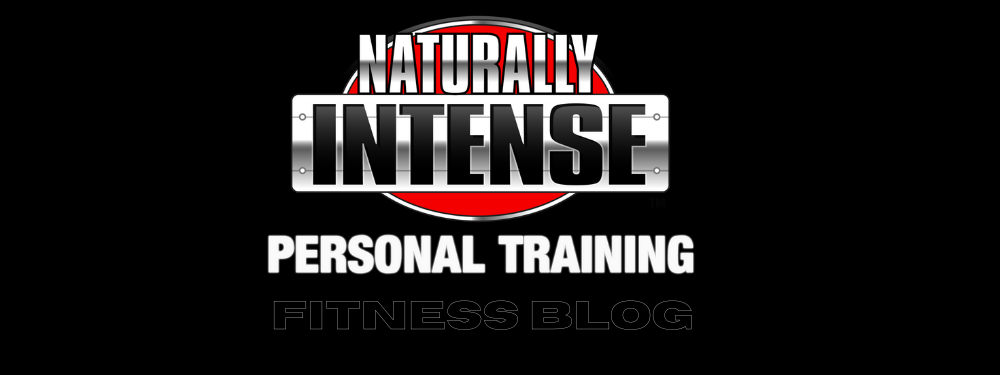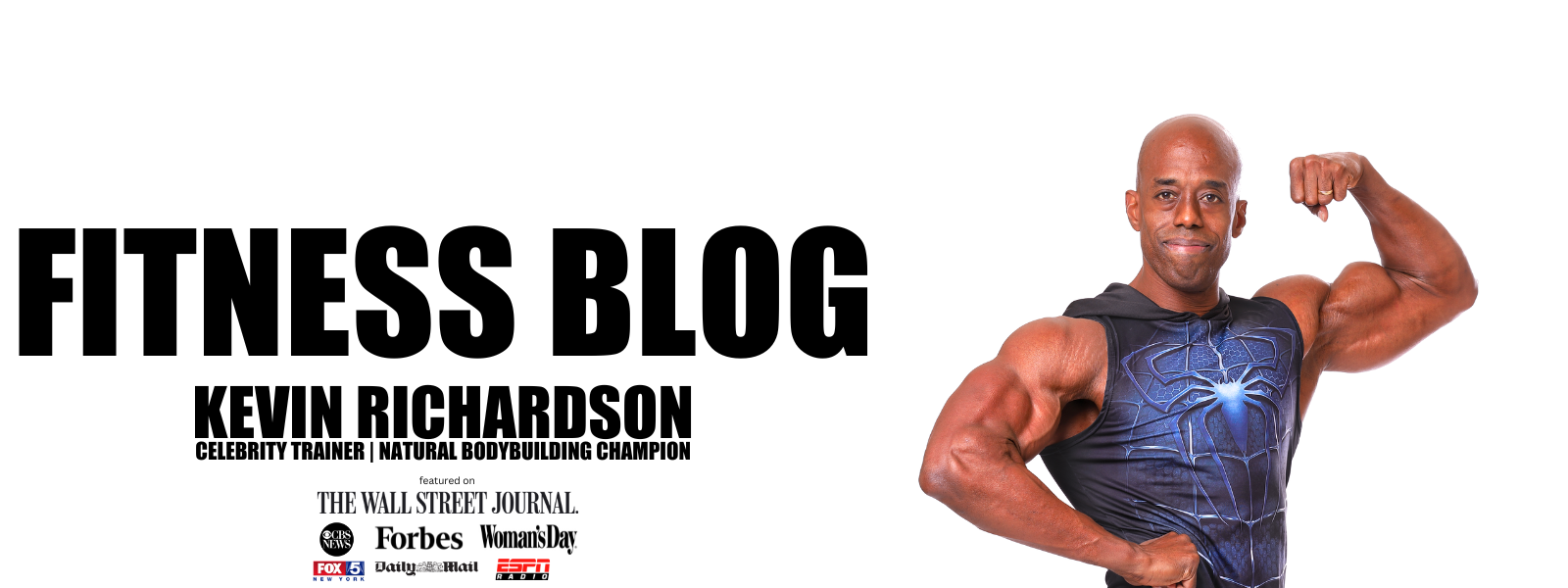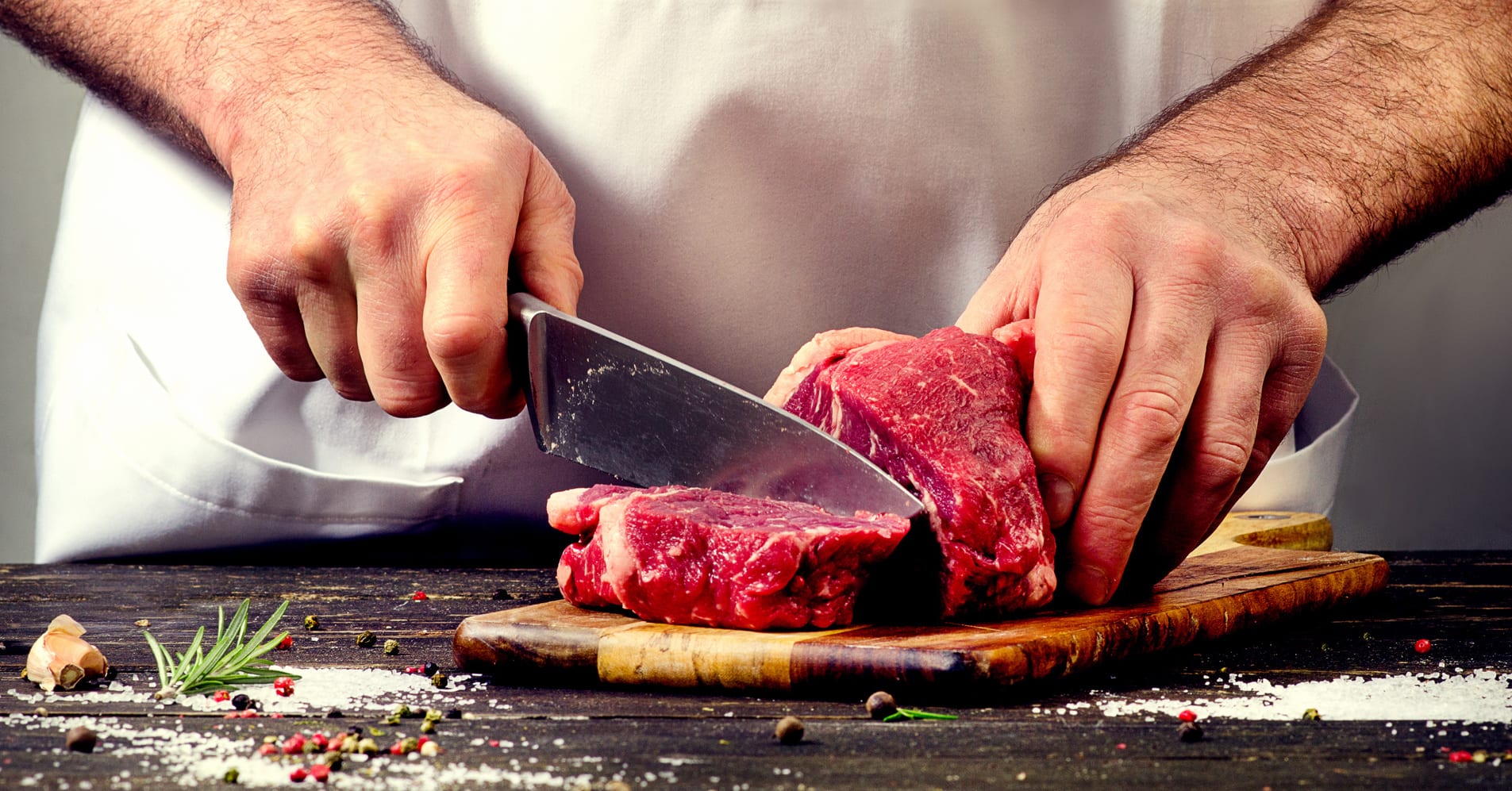
To Eat Meat Or Not To Eat Meat? What You Need To Know
Not that long ago the idea of not eating meat was almost unheard of in the Western World, save for a few independent minded individuals who made up a very small minority of the population. Today, even though the number of men and women who self describe as vegetarian here in the United States is relatively small, (less than 2.5% [1]) more and more people here and in other developed countries are limiting or stopping eating meat intake for health related reasons.[2] Reasons that come from a genuine concern about the quality of the current meat supply and the social and ethical questions that commercially raised meat sources raise.[3,4] To say there are problems with our commercial supply of meat, poultry and fish would be an understatement and while the ethical and social concerns have become popular issues, the health questions are seldom communicated to consumers. Consumers who generally have little idea of the changes in how our meat gets to our table over the course of our history and how these changes may have a tangible impact on our health as a whole. About a hundred and fifty years ago, farming and how our food made it to our pots was not an abstract idea or something you learned about in documentaries. Back then the percentage of individuals employed in the farming industry hovered at or around 70-80% [5,6] and farming was a part of our culture and not a well-kept corporate secret. Today that number is less than 2%-3%[5,6] and the very practices that have sustained us such as hunting and raising animals are no longer familiar acts. Which is ironic given that meat consumption has increased drastically over the years as well. Growing up in the West Indies, the study of agricultural science was mandatory at both primary and secondary school levels. The goal was not to create a nation of farmers, but to have a population that was well educated and informed about where our food came from. The disconnect here in the United States however, is very much intentional. As the conglomerates of the meat industry go to great pains to keep the public in the dark about how the meat on your plate finds its way there. A veil that keeps meat sales high and profits steady. Profits that are essential to the stability of the American economy, since the meat and poultry industry adds $864.2 billion annually to the U.S. economy, which is roughly 6% of the entire GDP.[7] Thus, it is not surprising that lobby backed food libel laws are on the books in several states, allowing the meat industry to file crippling lawsuits against any individuals making disparaging remarks about their products.[8] Fortunately, such laws do not extend to the quotation of scholarly studies and reports and this article will be the first in a series on how meat, poultry and fish supplies have changed over the years and why vegetarianism is fast becoming a default way of life for those interested in taking better care of their health.
Meat Then & Meat Now- From Wild Animals To Beef Hamburgers
The word ‘meat’ in the Western World has been synonymous with food of all kind and it is only in recent times that its meaning has changed to refer mostly to beef and animal tissue outside of chicken and fish.[1] That being said, this ubiquitous part of our early human diet is a far cry from what we would have eaten two hundred years, a thousand or even ten thousand years ago, and it’s important to understand the changes in our meat sources over the centuries. These changes are by no means trivial as they have very real significance for us in terms of our health. There is a growing awareness that rapid and profound changes in our diet can create an environment to which the human genome has not had adequate time to adapt.[9] With regards to meat, for the better part of 2.3 million years, our animal protein sources came exclusively from wild mammals with all other nutrients coming from wild plants.[9,10, 23,24,25]
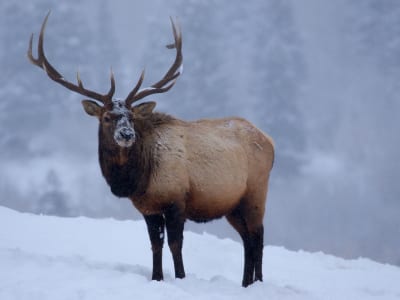
Beef, fish and poultry were not commonly found in the human diet until a relatively recent 20,000 years ago [11] while today here in the U.S. domestic animals account for all of our meat intake, with beef being the most commonly consumed meat.[40] Contrast this with the fact that estimates from over 229 hunter gatherer societies, (the closest approximate we have to Neolithic human practices), find that wild meats and related products can make up as much as 68% of their total caloric intake with the remaining 32% coming from wild plants and tubers.[12,13]. (Which, as an aside is a protein intake far higher than the 15% recommendations from the American Heart Association and the US Dept of Agriculture’s Food Pyramid. [14,15]- See my article on How Much Protein Do You Need?) Skeletons from the Upper Paleolithic period also confirm that early humans had a meat intake that is far greater than what consume today in developed countries. Yet cardiovascular disease, diabetes, colon cancers and other diet related diseases remain almost non-existent among hunter gatherer societies that eat meat in the quantities consumed by our ancestors.[16] Contrast this with the fact that over 64 million Americans have some form of cardiovascular disease, which is by far the leading cause of death here in the United States,[17] and that millions more suffer from hypertension, diabetes, obesity and other diet related diseases. Such numbers make it hard to conclude that eating meat is the problem, as even in large amounts other populations do just fine and have done so for thousands of years.[16] The question that should be asked is how does the meat we eat today compare to the meats eaten by populations that don’t have alarming rates of diet related disease.

It would be a mistake to blame high rates of metabolic disease solely on modern sources of meat. As the causes of diet related disease are legion and complex to say the least. Excessive consumption of fatty meats (which we talk about shortly), excess dairy products, high intakes of refined cereals, refined sugars, refined oils, salt and combinations of these foods along with low activity levels all contribute to adversely affecting our health and form the foundation of virtually all chronic diseases associated with modern civilization.[11] Over-consumption of fatty meats, nevertheless is a contributing factor and it is important to note that domesticated livestock today are far different in terms of fat quality and quantity from the wild mammals we ate for the better part of our time on the planet.[16, 18] Unlike domesticated animals that are consumed at the end of a predetermined life cycle when they are at their fattest, wild animals (as any avid hunter would know) vary greatly in body fat content based on age, gender, size of the animal (smaller animals tend to have less fat) and the time of the year. Wild mammals also gain and lose body fat in a cyclical manner in keeping with the seasons and the varying availability of food.[19,20] That being said, wild animals have relatively high body fat for only a few months out of the year- a fact that interestingly enough holds true for wild mammals in the tropics and warmer climates as well.
Wild Animals Vs Domesticated Animals- Understanding The Differences
Fat in and of itself is not a bad thing. Mammals store excess calories as fat as an energy reserve that allows them to survive droughts, famines and the leaner months of the year when food isn’t as abundant. This storage mechanism holds true whether you are a whitetail deer or office worker. And it is how we mammals have survived the harsh environments that Mother Nature can present. Fats aren’t all the same, nor are they stored the same way. In mammals, more than 50% of the fat in the subcutaneous and abdominal areas comprise of saturated fatty acids (SFA’s), while the major fat tissue found in muscle and other organ tissues are polyunsaturated fatty acids (PFA’s) and monounsaturated fatty acids (MFA’s).[21] Now because wild animals lose most of their abdominal and subcutaneous fat for the greater part of the year, their meat yield is mostly lean muscle tissue consisting of polyunsaturated and monounsaturated fats. That said, since wild mammals were our primary protein source for over 2 million years, high amounts of saturated fats would not have been a natural part of our formative diet. [9,21]
The Impact Of Farming on Nutrient Content
When humans started rearing animals for meat some 10,000 years ago, the onus was on getting the animal to as high a body fat content as possible before killing and consuming it. A feat that was accomplished by storing additional plant foods (hay, for example) for the animals to eat during the leaner times of the year. By keeping the animals well fed all year round, they got fatter than their wild counterparts and the higher fat content increased in the amount of saturated fats added to the human diet. Products made from such fats like as such as cheese, butter and tallow became convenient ways of storing calories using saturated fats as a food source. Foods that are still part of our diet today.
Meat & Fat Intake
Substantial evidence exists that when it comes to preventing chronic disease, it isn’t about how much fat you consume but rather the type of fats that are in your diet, and of course, how many calories you consume.[22] Monounsaturated fats and some polyunsaturated fats have been shown to have a role in stabilizing blood sugar, preventing diabetes and decreasing your risk of heart disease.[22] Omega-3 fatty acids have well documented cardio-protective effects as well, [27,28,29,30]and wild meats consumed as they are in hunter gatherer societies contain very high levels of omega-3 fatty acids.[26] A nutrient that is very much lacking in the modern Western diet, as grain fed beef has very low levels of heart friendly omega-3 fatty acids and even grass fed meat has far lower omega-3 levels than wild game. (See my article on omega-3 fatty acid sources here) Saturated fat has been maligned as a causative factor in cardiovascular disease and many institutions such as the World Health Organization, recommend lower intakes as a preventative factor against heart disease[15,31] However, many studies contradict these findings[32] and so do the examples of non-Western societies that consume large quantities of saturated fats without major incidences of cardiovascular disease. But it should be noted that the meat and meat derived products consumed in those parts of the world are not the same as what we eat here in the United States.
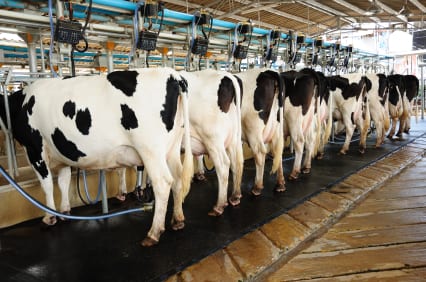
In many parts of the world, the bucolic picture of livestock grazing on verdant pastures was very much the norm. But in many developed countries, this picture was replaced thanks in part to the advent of new technologies developed during the Industrial Revolution. By the 1850’s, those new technologies allowed for larger grain harvests and better transportation of both grain and cattle.[33] With this came the practice of feeding cows an increasingly grain based diet, since grain was found to be far easier (and cheaper) to grow and store than grass. The problem is that grains are not a natural part of a cow’s diet. The digestive tract of a cow evolved over millions of years to be able to digest grass and it is designed to do just that. A cow’s stomach acts like a giant fermentation plant, containing large amounts of bacteria that converts grass into the nutrients the cow needs to grow and produce meat. The more concentrated fats, proteins and carbohydrates found in grains such as corn and soy create a serious dilemma for a cow’s digestive system. Eating grain based feed makes cattle grow fatter in the same way feeding processed foods that are not part of our natural diet makes humans fatter. And the consequences are just as deadly for cows. Grains alter the delicate balance of bacteria a cow’s gut and so the animal suffers a never ending case of indigestion, which ultimately brings about its early demise. This isn’t something farmers worry about though as cows reach market weight and are slaughtered long before the premature death that they would suffer from eating a grain based diet.[5]
Increased Profits From Grain Feeding Come With Increased Incidence of Sick Livestock
Unlike their grass eating and free ranging counterparts, grain fed cows are sickly by nature. Cattle are penned in feedlots so they move less and grow fatter faster, but this adversely affects their health, as it would any other animal. Cattle, like all animals, evolved to have a certain level of movement and activity as a natural part of their grazing habits. Activity that is impossible to replicate when penned inside a feedlot. [33] Before 1850, almost all the cattle in the United States were free range or pasture fed, and it would take 4 to 5 years for cattle to reach the size where they were deemed ready for slaughter. By 1885, the use of feedlots and overfeeding, made it possible to raise a cow weighing well over a ton in as little as 2 years. This practice then introduced another new addition to the human diet in the form of marbled meat.[5] Meat that is unnaturally high in saturated fats. Higher saturated fat content means less muscle, and less muscle means that the meat is more tender and ‘juicy.’ All qualities that consumers prefer, ones that are not necessarily healthy.
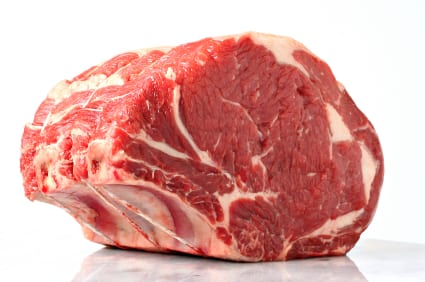
Marbled Meat- A Novel Addition To The Human Diet
Most people are unaware that the marbled meat in the supermarket of developed countries have only been a part of our diet for less than 150 years. An important consideration for anyone eating commercial beef as part of a ‘Paleolithic’ dietary approach. As grain fed meat is very far removed from what our pre-agricultural ancestors would been eating.[23,24,24] Marbled meat not only has a much higher percentage of saturated fats compared to wild and natural meats, but it grain fed cattle also have a shift in shifts the balance of omega 3 fatty acids. From being naturally high in n-3 fatty acids (the good omega 3’s) to low in n-3’s and high in n-6 fatty acids [34] (See my article on omega 3’s for a more in-depth look at the differences in omega-3 fats brought on by feeding cattle grain instead of grass.) How much more fat does marbled meat have when compared to the wild meat we ate for such a long period in our history? To get an idea consider the fact that the muscle tissue of wild mammals on average contains half the total fat of grain fed beef AFTER the grain fed beef has been carefully trimmed of all visible fat.[34] The increase in fat also comes with an increase in calories and so a larger portion of wild or grass fed meat would have substantially less calories pound per pound compared to grain fed beef. It’s quite a difference and the differences don’t stop there.
Antibiotics & Meat- A Necessary Evil for Maximum Profits
After the advances of the later 1800’s, technology for overfeeding and confining cattle became even more efficient. Creating cows with 30% body fat[35] and weighing over a ton in as little as 14 months.[36] As we noted earlier, these cows are often sickly from being penned together in close proximity with no room for exercise. This made preventative antibiotics and antimicrobials a necessity to sustain the industry as the livestock would die without them. The same drugs that we use regularly to treat human ailments such as tetracycline, strepogramin and penicillin, are not only used to prevent disease in livestock, but also to make them grow faster and thus increase profits.[37] This practice of giving livestock antibiotics regularly as a preventative continues in spite of the fact that the World Health Organization, US Center for Disease Control & Prevention and the American Medical Association all agree that the use of antimicrobials in livestock is the main cause of antibiotic resistance in food borne illnesses. It is also the consensus that prophylactic antibiotic use in animals is a significant contributor to the emergence of antibiotic resistant diseases in humans.[5] Many countries heed these warnings and use more traditional ways of farming to keep their cows healthy. Countries in the European Union for example, have strict laws prohibiting the use of antibiotics used to treat humans as a preventative tool in livestock. Yet, here in the United States, estimates are that we use between 17.8 and 24.6 million tons of antibiotics on farmed animals every year. [5] A figure that dwarfs the mere 3.4 million tons of antibiotics used worldwide in human medicine each year.[5,38] It’s even more disturbing when you consider that free ranging livestock seldom ever get sick and almost never require antibiotics at any stage of their lives.
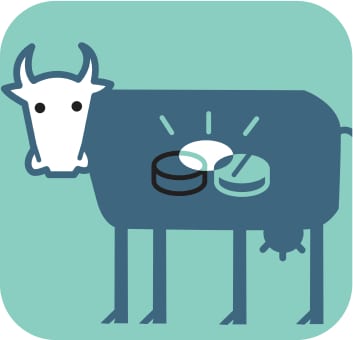
Feeding grain to cows also affects the delicate PH balance of their guts and causes increased growth of other forms of bacteria such as Escherichia coli (E. coli) and Campylobacter. Bacteria that would ordinarily not exist in significant amounts among cows that eat grass, but with the unnatural shift in food sources comes the increase in bacteria. Bacteria that has little physical effect on cows, but can make humans ill and can even be fatal when we consume the meat. Think about it. every one of the millions of cases of food poisoning every year due to meat consumption could be prevented by simply eating meat only ate grass and lived a natural life.
Organic Meat- Is It Really Better Or Even Grass Fed?
It would be overly romantic to believe that a diet of farm raised chicken and beef could realistically be part of popular ‘Paleolithic’ diets as neither of these meats existed in a pre-agricultural diet. So what can we do to emulate a more natural human diet? There are several options available that offer somewhat better, but not always perfect meat solutions to consumers. Unfortunately even those standards are often questionable. The term ‘natural’ or ‘grass fed’ pops up on the labels of a growing number of meat products, but no tangible guidelines exist and there is no official system of accountability to verify what these claims actually mean. In response to consumer lobbying, the USDA established the ‘certified organic’ label. Which means that inspectors are regularly sent out to determine whether the following rules are applied to animals raised:
- That no animal products are used in the feed
- That there is no use of antibiotics or hormones to increase growth rates
- Livestock must have regular access to fresh air, freedom of movement and access to pasture (grass fed)
- All feed must be 100% organic- that is no pesticides or artificial fertilizers can be used to grow it. [39]
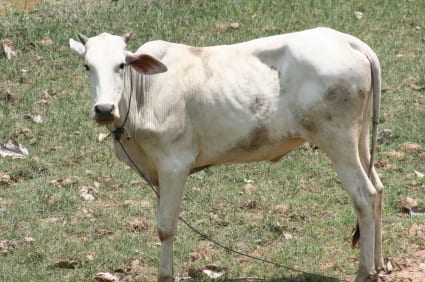
As you surmise from these guidelines, even ‘certified organic’ meat can still be grain fed, and for most farmers, the cost of organic grain is so expensive that they simply cannot afford to use it if they are to remain competitive in the market. The ‘certified organic’ label isn’t perfect, but it does make for higher standards, especially in terms of antibiotic use and ethical activity levels for the livestock. The term ‘grass fed’ is also misleading as it has no real official definition and is often more marketing than truth. Marketing that serves to make the consumer feel better about (and pay more for) their meat. Meat labeled as ‘grass fed’ does not specify for how long it was grass fed, nor detail it say what percentage of the animal’s regular diet came from grasses, as many farmsfeed livestock grain and grass at the same time.[39] Then there is the problem with meats labeled as ‘natural.’
‘Natural’ Meat- Making The Consumers Pay More For A Meaningless Label
The term ‘natural’ according to USDA specifications means only that the meat has no artificial flavors, colors or preservatives and that it was ‘minimally processed.’ Those terms are open to interpretation since no official enforcement of these specifications exist. So while many brands use the ‘natural’ to increase sales and the perceived healthiness of their products, the fact that they are not eligible for the USDA ‘certified organic’ label makes their claims suspect.[39] Many health conscious consumers buy meat labeled ‘natural’ as it is much cheaper than certified organic brand, yet gives the sense that the meat is somehow a better choice ethically and in terms of health. But, in many cases, ‘natural’ meats are no different than conventional meats, except for the higher tag. So if ‘certified organic’ beef is considered too expensive, and is not as widely available since organic brands are a relatively small percentage of the market, what should someone who wants to eat meat that is does not conflict with their ethical and health standards do?
The answer is buying meat directly from small traditional farms. As such purchases are an exercise in voting with your dollar and gives you a better chance of getting meat that is truly grass fed and ethically raised and harvested. Bear in mind, that even grass fed beef still pales in comparison to wild meat in terms of having higher levels of omega-3 fatty acids and lower saturated fat content.[34] Beef is also far more a novel addition to our diets but since we don’t live in a perfect world, procuring truly wild meat is prohibitively expensive for most and impractical for others. Technology and innovations in farming were designed to make meat cheaper (and thus more profitable). But these increases profits sacrifice quality, ethical standards, cost to the environment and best practices for consumer health in the name of making more money. Only the fortunate few are able to afford (and have access to) truly grass fed or wild meat on a regular basis. What options does this leave for the rest of us? It leaves us with a hard look at the facts and the need to make some very hard personal choices about to what we are willing to eat. This series is meant to be a guide to highlighting the questions we should be asking ourselves and understanding the changes in our food supply over the course of modern and ancient history. As always, I thank you for reading my work and I hope that you will share it with others who may find it beneficial.
Related Articles:
Eating Chicken- What You Need To Consider
How Much Protein Do You Really Need To Build Muscle?
High Intensity Bodyweight Training: Ballistic Pushups & Dips!
This was a tough one!
Starts out with ballistic push ups (like clap pushups but without the clap as my wrist is still not 100%) nonstop for 20 reps, then all out on dips for 10 reps.
To say it was painful would be an understatement, but you just have to push through and keep on going.
Still training, hope you are too and as always, Excelsior!!! #naturallyintense
#hometraining #homeworkout #homeworkout #highintensitytraining #naturalbodybuilder #naturalbodybuilding #fitover40 #naturalbodybuildingvideos #chestday #chesttraining #naturalbodybuildingtips #pushups #dips #bodyweighttraining #highintensitytrainingtips #drugfreebodybuilding #calesthenics
Kevin's Unconventional Biceps Training- 3-6 Minutes a Week!
In this video I go over my biceps training using the Naturally Intense High Intensity Training protocols that helped me go from having arms measuring 11.5 to 12 inches to 18 inches drug free!
It's an unconventional approach for certain, but it's one that's helped my arms grow and the hundreds of men and women I have trained over the past 30 plus years.
Now, my success isn't due to being genetically gifted, as it took me the better part of 11 years to get my arms up to those measurements.
Which is significant as it works and been been proven time and time again to work for the average man or woman trying to grow their arms without drugs.
It's my hope that these high intensity training protocols can help you as much as they helped me!
Click on my bio link to see the full video on my YouTube channel and thanks as always for taking the time to look at my work!!! Excelsior!!! #naturallyintense
#highintensitytraining #naturalbodybuilder #naturalbodybuilding #fitover40 #naturalbodybuildingvideos #armworkout #bicepsworkout #naturalbodybuildingtips #biceps #armtraining #highintensitytrainingtips #drugfreebodybuilding #barbellcurls
At the Lancaster Classic Day 2 Elimination Rounds Against European Champion, and World Record Holder Leo Pettersen @leo_barebow_archer
I don't talk much about it but I'm also a competitive barebow archer (surprise!) and last Saturday I had the honor of making it to Day 2 at the Lancaster Archery Classic in the Barebow Division, as I made the top 64 out of 267 competitors and had a chance to shoot with some of the greatest barebow shooters on the planet!
I didn't make it past Leo, but it was a real rush to be there and a huge thanks to my coach, Joe MyGlyn @prolinearchery for helping me get there.
Thanks as well to my good friend @sean_chan33 for all of his help from the very start, to my line buddy Aaron Shea for taking the shot and showing up to support!
My thanks as well to rob_kaufhold for putting on and promoting one of the best archery tournaments on earth!
Thanks also to to everyone who took the time to send a supporting word and I am looking forward to next year!!! #naturallyintense #barebow
#lancasterclassic #lancasterarcheryclassic2024 #lancasterarchery #archery #fitover40 #barebowrecurve #targetarchery
Dumbo, Brooklyn circa 2004
This shot was taken as part of the promotion for my Naturally Intense DVD and was about a year after my last bodybuilding competition.
It was a grueling photoshoot.
We started at about 10 am and finished around 4pm and I was completely spent, but the more we shot the sharper I looked, so we kept on going.
It's nice to look back from time to time and as tired as I was, we all had a blast!
My thanks to @stephanie_corne_artwork, @https://pulse.ly/itgnag2dec and @ftaz1 for taking the shots!!!
Thanks for watching and as always, Excelsior!!! #naturallyintense
#naturalbodybuilder #naturalbodybuilding #throwback #fifthavenuegym #5thavenuegym #drugfreebodybuilding #naturalbodybuildinglifestyle #gymlife #gymmotivation #naturalbodybuildingmotivation #bodybuilding #blackandwhite #instablackandwhite #bnw
Can You Build An Impressive Physique Training Only At Home?
Absolutely!
I stopped training in commercial gyms as of March 2020 and have been training at home ever since.
Initially I was admittedly worried that I might lose some of my gains or not make as much progress, but that certainly wasn't the case.
I've consistently continued to improve with my high intensity workouts and muscles have no idea where they are training.
As long as the criteria of adequate intensity and overload are met, there will be an adaptive response and your muscles will get bigger and stronger.
So don't worry at all about where you train, focus instead of what will be the best way for you to always be training!
Thanks for watching and as always, Excelsior!!! #naturallyintense
Kevin's Three Day Training Spilt!
For the past 33 years I have trained three times a week with Naturally Intense High Intensity Training workouts lasting 10, 15 to 20 minutes max.
It's a training split tried and testes not only in it's helping me realize my goal of becoming a successful natural bodybuilder, but it's also helped hundreds of men and women over the past three decades.
I have tested just about every possible training split imaginable and for this particular style of high intensity training, this particular grouping consistently yields fantastic results.
I hope it helps you as much as it's helped me over the years and thanks so much for taking the time to look at my work.
Keep training hard and Excelsior!!! #naturallyintense
Excelsior!!! #naturallyintense
#trainingsplit #3daytrainingsplit #threedaytrainingsplit #naturalbodybuilding #naturalbodybuilder #naturalbodybuildingvideo #naturalbodybuildingmotivation #naturalbodybuildingtips #drugfreebodybuilding #bodybuilding #highintensitytraining #highintensitytrainingtips
405 Stiff Leg Deadlift for 7 Reps! High Intensity Training.
First leg workout of the year and already pushing it!
I haven't done a stiff leg deadlift over 315lbs for about 3 years at this point, and I did my last set with 315lbs and comfortably got to 10 reps and decided I had far too much gas left in the tank and that I should go up in weight.
So I did.
I figured I might get a solid 6 reps in, but I made it to 7 and I think I could have gone on to get a full 10 reps BUT that's when good judgement prevailed.
As a bodybuilder having not trained this heavy for so many years, the shock of this much weight would be more than enough to stimulate muscle growth, and doing more reps wouldn't yield any greater returns, only increase the likelihood of injury.
It's not about the numbers, it's about training to a point where you achieve your goal, and it's important to have a goal in mind as a bodybuilder based on increasing muscle mass rather than hitting a particular number.
Besides, if in my 20's I never did more than 405lbs on a stiff leg deadlift, it doesn't make any sense going heavier than when I am almost 50!
Could I deadlift more at this point?
Absolutely but just because you can doesn't mean you should!
So keep those weights in a good working range, keep it safe and as always Excelsior!!! #naturallyintense
#hometraining #homeworkout #homeworkout #roguerack #highintensitytraining #naturalbodybuilder #naturalbodybuilding #fitover40 #naturalbodybuildingvideos #backworkout #naturalbodybuildingtips #backtraining #highintensitytrainingtips #drugfreebodybuilding #fitoverforty #deadlift
Turning 50 in a few months...
Not much of a big deal for me as I still feel pretty much the same but I hope that my example helps show what can be done with a lifetime commitment to eating well and training consistently!
Thanks for coming along on the journey and as always, Excelsior!!! #naturallyintense
#naturalbodybuilder #naturalbodybuilding #healthylifestyle #fitover40 #drugfreebodybuilding #naturalbodybuildingmotivation #natty #fitness
Please note that all material is copyrighted and DMCA Protected and can be reprinted only with the expressed authorization of the author.
Click To Get A Copy Of Kevin’s Free Ebook On The Role Of Exercise In Reducing Abdominal Fat!
Featured everywhere from the Wall Street Journal to network TV, Kevin Richardson is the international fitness consultant for UNICEF, natural bodybuilding champion, creator of Naturally Intense High Intensity Training and one of the most sought after personal trainers in New York City. Learn more about his personal training services NYC
References for To Eat Meat Or Not To Eat Meat- What You Need to Know:
- The Vegetarian Resource Group How many vegetarians are there?
- Jacobsen MF. Six arguments for a greener diet: how a more plant-based diet could save your health and the environment. Washington, DC: Center for Science in the Public Interest, 2006.
- Fox N, Ward K. Health, ethics and environment: a qualitative study of vegetarian motivations. Appetite 2008
- 5. Rollin BE. Farm animal welfare: social, bioethical, and research issues. Ames, IA: Wiley-Blackwell, 2003
- Stull, DD, Broadway MJ. Slaughterhouse Blues: The Meat and Poultry Industry in North America (Case Studies on Contemporary Social Issues) Cengage Learning. 2003
- USDA United States Dept of Agriculture. National Institute of Food & Agriculture: Extension 2011
- The United States Meat Industry at a Glance. The American Meat Institute (AMI) 2013
- Food-Disparagement Laws: State Civil & Criminal Statutes Coalition for Free Speech Food Speak 1998
- Cordain L, Eaton SB, Sebastian A, Mann N, Lindeberg S, Watkins BA, O’Keefe JH, Brand-Miller J. Origins and evolution of the Western diet: health implications for the 21st century. Am J Clin Nutr. 2005
- The Vegetarian Resource Group How many vegetarians are there? 2000
- Eaton SB, Konner M, Shostak M. Stone agers in the fast lane: chronic degenerative diseases in evolutionary perspective.AmJ Med 1988
- Cordain L, Brand Miller J, Eaton SB, Mann N, Holt SHA & Speth JD: Plant to animal subsistence ratios and macronutrient energy estimations in worldwide hunter-gatherer diets. Am. J. Clin. Nutr. 2000
- Abrams HL. The relevance of Paleolithic diet in determining contemporary nutritional needs. J Appl Nutr 1979
- Krauss RM, Eckel RH, Howard B, et al. AHA dietary guidelines: revision 2000: a statement for healthcare professionals from the Nutrition Committee of the American Heart Association. Circulation 2000
- U.S. Department of Agriculture and U.S. Department of Health and Human Services. (December 2010). Dietary Guidelines for Americans, Washington, DC: U.S. Government Printing Office. 2010
- Cordain L, Eaton SB, Miller JB, Mann N, Hill K. The paradoxical nature of hunter-gatherer diets: meat-based, yet non-atherogenic. Eur J Clin Nutr. 2002
- American Heart Association. Heart and stroke statistics—2004 update. Dallas: American Heart Association, 2003.
- Pitts CG, Bullard TR. Some interspecific aspects of body composition in mammals. In: Body composition in animals and man. Washington, DC: National Academy of Sciences, 1968
- Spiess AE. Reindeer and caribou hunters: an archaeological study.New York: Academic Press, 1979.
- Mercer JG. Regulation of appetite and body weight in seasonal mammals.Comp Biochem Physiol Part C 1998
- Cordain L, Watkins BA, Florant GL, Kehler M, Rogers L, Li Y. Fatty acid analysis of wild ruminant tissues: evolutionary implications for reducing diet-related chronic disease. Eur J Clin Nutr 2002
- Institute of Medicine of the National Academies. Dietary fats: total fat and fatty acids. In: Dietary reference intakes for energy, carbohydrate, fiber, fat, fatty acids, cholesterol, protein, and amino acids (macronutrients). Washington, DC: The National Academy Press, 2002
- Defleur A, White T, Valensi P, Slimak L & Cregut-Bonnoure E:Neanderthal cannibalism at Moula-Guercy, Ardeche, rance.Science 1999
- Marean CW & Assefa Z: Zooarcheological evidence for the faunal exploitation behavior of neanderthals and early modern humans. Evol. Anthrop.1999
- Stanford CB & Bunn HT: Meat eating and hominid evolution. Curr. Anthrop 1999
- Simopoulos AP (1999): Evolutionary aspects of omega-3 fatty acids in the food supply. Prostaglandins Leukot. Essent. Fatty Acids
- von Schacky C. “The role of omega-3 fatty acids in cardiovascular disease”. Curr. Atheroscler. 2003
- Morris, Martha C.; Sacks, Frank; Rosner, Bernard. “Does fish oil lower blood pressure? A meta-analysis of controlled trials”. Circulation 2003
- Mori, Trevor A.; Bao, Danny Q.; Burke, Valerie; Puddey, Ian B.; Beilin, Lawrence J. “Docosahexaenoic acid but not eicosapentaenoic acid lowers ambulatory blood pressure and heart rate in humans”. Hypertension 1993
- Harris, William S. “n−3 fatty acids and serum lipoproteins: human studies”. Am J Clin Nut 1997
- Hooper L, Summerbell CD, Thompson R, Sills D, Roberts FG, Moore H, Smith GD (July 2011). “Reduced or modified dietary fat for preventing cardiovascular disease”. The Cochrane Library
- The role of reducing intakes of saturated fat in the prevention of cardiovascular disease: where does the evidence stand in 2010?”. American Journal of Clinical Nutrition 2011
- Whitaker JW. Feedlot empire: beef cattle feeding in Illinois and Iowa, 1840-1900. Ames, IA: The Iowa State University Press, 1975.
- Cordain L, Watkins BA, Florant GL, Kelher M, Rogers L, Li Y. Fatty acid analysis of wild ruminant tissues: evolutionary implications for reducing diet-related chronic disease. Eur J Clin Nutr. 2002
- Wells RS, Preston RL. Effects of repeated urea dilution measurement on feedlot performance and consistency of estimated body composition in steers of different breed types. J Anim Sci 1998
- Pollan M. Power steer. New York Times Magazine. 2002.
- Report on the Policy Commission on the Future of Farming and Food 2002
- Mellon, Benbrook & Benbrook. Hogging It- Estimates of Antimicrobial Abuse in Livestock. Union of Concerned Scientists 2001
- M Nestle. What To Eat. North Point Press; 1st edition 2007
- The United States Meat Industry at a Glance-The American Meat Institute (AMI) 2013
